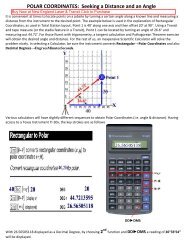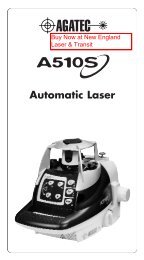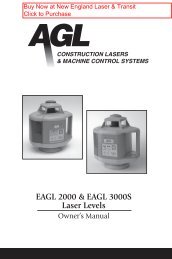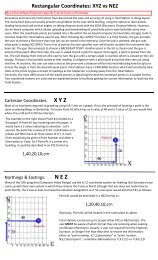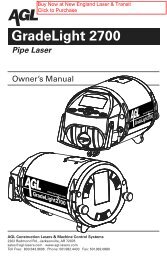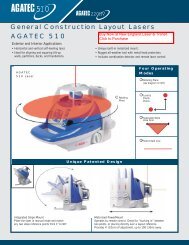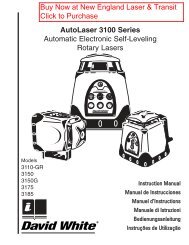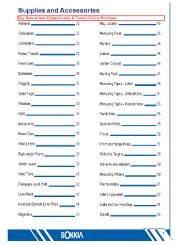South ET-05 Electronic Digital Theodolite Manual - New England ...
South ET-05 Electronic Digital Theodolite Manual - New England ...
South ET-05 Electronic Digital Theodolite Manual - New England ...
You also want an ePaper? Increase the reach of your titles
YUMPU automatically turns print PDFs into web optimized ePapers that Google loves.
<strong>South</strong> <strong>ET</strong>-<strong>05</strong> <strong>Electronic</strong> <strong>Digital</strong> <strong>Theodolite</strong> <strong>Manual</strong><br />
·I·<br />
CONTENTS<br />
1. FEATURES ................................................................................................................................................ 1<br />
2. PREPARATIONS ...................................................................................................................................... 2<br />
2.1 Precautions....................................................................................................................................... 2<br />
2.2 Parts ................................................................................................................................................. 3<br />
2.3 Unpacking and Storage ................................................................................................................... 4<br />
2.4 Battery and Charger ....................................................................................................................... 4<br />
2.5 Assemble and Disassemble the Basal Stump ................................................................................. 5<br />
3.KEYBOARD AND PANEL<br />
3.1 Keyboard.......................................................................................................................................... 7<br />
3.2 Panel ................................................................................................................................................. 7<br />
3.3. Display Information<br />
4. INITIAL S<strong>ET</strong>TING .................................................................................................................................. 9<br />
4.1 Setting Items .................................................................................................................................... 9<br />
4.2 Setting Method ................................................................................................................................ 9<br />
5. PREPARATION FOR SURVEY ........................................................................................................... 11<br />
5.1 Centering and Leveling ................................................................................................................. 11<br />
5.2 Eyepiece Adjustment and Object Sighting .................................................................................. 12<br />
5.3 Power On or Off ............................................................................................................................ 13<br />
5.4 Vertical Index Zero Setting (V 0S<strong>ET</strong>) .......................................................................................... 14<br />
6. BASIC SURVEY ..................................................................................................................................... 15<br />
6.1 Observation from Normal/Reversed Position ............................................................................. 15<br />
6.2 Horizontal Angle “0” Setting (0 S<strong>ET</strong>) ......................................................................................... 15<br />
6.3 Horizontal and Vertical Angle Measurement.............................................................................. 16<br />
6.4 Lock and Unlock Horizontal Angle (HOLD) .............................................................................. 16<br />
6.5 Quadrant Sound of Horizontal Angle Setting ............................................................................. 17<br />
6.6 Vertical Angle “0” Setting ............................................................................................................. 17<br />
6.7 Measure Zenith Distance and Vertical Angle .............................................................................. 18<br />
6.8 Slope Percentage ............................................................................................................................ 19<br />
6.9 Repeat Angle Measure .................................................................................................................. 20<br />
6.10 Export Angle ................................................................................................................................ 21<br />
6.11 Save Angle .................................................................................................................................... 22<br />
6.12 Measure Distance with Stadia .................................................................................................... 22<br />
7. MEMORY ................................................................................................................................................ 23<br />
7.1 Examine Instrument’s Serial Number ........................................................................................ 23<br />
7.2 Examine Angle Data in Memory .................................................................................................. 23<br />
7.3 Clear Angle Data in Memory ....................................................................................................... 24<br />
7.4 Transmit Data in Memory to Serial-port<br />
8. CONNECTION WITH CONTROLLER .............................................................................................. 25<br />
9. INSPECTION AND ADJUSTMENT .................................................................................................... 26<br />
9.1 Plate Vial ........................................................................................................................................ 26<br />
9.2 Circular Vial .................................................................................................................................. 26
<strong>South</strong> <strong>ET</strong>-<strong>05</strong> <strong>Electronic</strong> <strong>Digital</strong> <strong>Theodolite</strong> <strong>Manual</strong><br />
9.3 Inclination of Reticle ..................................................................................................................... 26<br />
9.5 Automatic Compensation for Vertical Index Difference ............................................................ 27<br />
9.6 Vertical Index Difference (I Angle) and Set Vertical Index Zero ............................................... 28<br />
9.7 Optical Plummet ............................................................................................................................ 29<br />
9.8 Other Adjustment .......................................................................................................................... 30<br />
10. SPECIFICATIONS ............................................................................................................................... 31<br />
11. COMMON MISTAKE .......................................................................................................................... 33<br />
12. ACCESSORIES ..................................................................................................................................... 34<br />
·II·
1. FEATURES<br />
<strong>Electronic</strong> theodolites of <strong>ET</strong> Series are designed by our company according to the concept of reasonable<br />
structure, smart appearance, reliable performance, various functions and easy operation. Not only easy to<br />
realize all functions, but also it has the features below:<br />
Able to Connect with <strong>Electronic</strong> Controller<br />
Able to connect with most of the electronic controllers on the market to complete field data collection<br />
automatically.<br />
Easy to Operate Key-press<br />
It only has 6 keys which can realize all measure functions and can show distance data from range finder on<br />
monitor.<br />
Can operate in dark place<br />
Telescope’s crosshairs and screen are equipped with illumination resource so that you can operate it in dark<br />
place.<br />
·1·
2. PREPARATIONS<br />
2.1 Precautions<br />
(1)Avoid aiming the objective lens directly at the sun. When performing a measurement under sunshine,<br />
attach the filter to the objective lens.<br />
(2) Avoid storage or usage at extremely high or low temperature. Avoid subjecting it to rapid changes of<br />
temperature (refer to working temperature range).<br />
(3) Put into the carrying case for storage and place in a dry area when it isn’t used, do not subject to<br />
vibrating, dust or high humidity.<br />
(4) When the storage temperature and usage temperature is widely different, left the instrument in the case<br />
until it adapt to the surrounding temperature.<br />
(5) When not in use for long period, disassemble battery from <strong>ET</strong> and recharge the battery once per month.<br />
(6) Put the instrument into its case when transport. Make sure to keep it from squeeze, clash and shake. Had<br />
better put soft pad around the case during line-haul.<br />
(7) Be sure to secure the instrument with one hand when mounting or removing from the tripod.<br />
(8) When the exposed optical parts need to be cleaned, clean them with degreased cotton or lens-head paper,<br />
not with other things.<br />
(9) Be sure to clean the plastic parts and organic glass with water-soaked cloth, rather than chemical<br />
reagent.<br />
(10) When the measure is finished, clean the surface of your instrument with woolen cloth or fur brush. If it<br />
is wetted, never turn it on. Put it in the ventilation place for a period of time and rub it dry with clean cloth.<br />
(11) Before operation, carefully inspect the power, functions and indexes of the instrument, initial setting<br />
and correction parameters.<br />
(12) Do not disassemble the instrument by yourself, even if a malfunction is found, unless you are a<br />
professional.<br />
·2·
2.2 Parts<br />
Telescope Focusing Knob<br />
Objective Lens<br />
Focusing Knob for<br />
Centering<br />
Eyepiece for Optical Plummet<br />
Port for Controller<br />
Horizontal<br />
Tangent<br />
Screw<br />
Circular Vial<br />
Leveling Screw<br />
Plate Vial<br />
Horizontal<br />
Clamp<br />
Screw<br />
Top Handle<br />
·3·<br />
Eyepiece of Telescope<br />
Vertical Clamp Screw<br />
Vertical Tangent Screw<br />
Power Switch<br />
Base<br />
Handle Fixing Screw<br />
Coarse Collimator<br />
Center Mark<br />
LCD<br />
Keyboard<br />
Tribrach
2.3 Unpacking and Storage<br />
Unpacking<br />
Gently lay down the carrying case and set its cover upward, unlatch and open the case. Then, take the<br />
instrument out of the case.<br />
Storage<br />
Set the telescope close to horizontal or vertical, and lightly tighten the telescope clamp screw. Align the<br />
white dot; place the instrument into the case with the white dot towards you. close the case lid and lock the<br />
latch.<br />
2.4 Battery and Charger<br />
Assemble and Unassemble Battery<br />
(1)Press the top button of the battery box to take off the battery box.<br />
(2)Insert the bottom edge of the battery into the slot on the standard cover, and put the top button of the<br />
battery into the cover until it clicks.<br />
Battery Information<br />
Full battery can last for 8 to 10 hours continuously. The symbol “ ”in the lower right corner of the<br />
screen displays power consumption message. Power consumption is as follows:<br />
and indicate that energy is abundant.<br />
indicates there is a little energy left, and ready to replace or recharge it .<br />
twinkling indicates it will turn off in few minutes due to lack of energy, so stop operating<br />
Charging Battery<br />
and change battery ASAP.<br />
Please use special charger (10A) to recharge battery in instrument which is 10A, NiMH rechargeable one.<br />
Insert the battery charger into the power source with 220V, then red light lights. Take off the on-board<br />
battery from the main body and connect the plug of the charger to charge jack on the battery. The indicating<br />
lamp is red indicates the battery is recharging and it turns green in 6 hours means charge completes. Then<br />
remove the plug from the charge jack.<br />
Warning: if the battery is placed improperly, it may cause explosion. Please deal with used<br />
battery in the light of manual.<br />
Note on taking off the battery box!<br />
Before you take off the battery box, make sure that the power of the instrument is<br />
turned off. Otherwise, the instrument can be damaged.<br />
Notes on recharging!<br />
·4·
Notes on storage!<br />
Rechargeable battery can be repeatedly recharged 300-500 times. Complete discharge<br />
of the battery may shorten its service life.<br />
In order to get the maximum service life, be sure to recharge it once per month.<br />
Do not place the battery in the hot and wet place and never make it short-circuit, or it<br />
will mangle battery.<br />
Dispose and recycle battery properly according to local rules. Do not flip it into fire.<br />
2.5 Assemble and Disassemble the Basal Stump<br />
Disassembly<br />
If necessary, the instrument can be removed from the triangle basal stump. First, loosen the triangle basal<br />
stump locking screw with a screw-driver. Then, turn the locking button about 180°in counter clockwise and<br />
take off the instrument from the triangle basal stump.<br />
Installation<br />
The charger has a built-in circuit for protection from overcharge. However, do not<br />
leave the charger plugged into the power after recharge is completed, because it will<br />
shorten life-span of battery.<br />
Be sure to recharge the battery at a temperature of 0 ℃~+45℃。Charge may be<br />
abnormal beyond the specified temperature range.<br />
Forbid using any already broken charger and battery.<br />
Fit directing convex mark to the directing concave on the tribrach. Put the three fixing feet into the holes<br />
respectively. Turn the locking button clockwise about 180º to fix the instrument to tribrach, then tighten<br />
the fixing screw of the locking button with a screw driver.<br />
Instrument fixing feet<br />
Tribrach<br />
Basal stump<br />
·5·<br />
Directing convex mark<br />
Directing concave<br />
Basal stump locking button Lock button’s fixing screw
·6·
3. KEYBOARD AND PANEL<br />
3.1 Keyboard<br />
Each key on the keyboard has double functions. Generally, instrument performs the first basic function of<br />
press-key. It will carry out the second extended function marked above key after pressingFUNC.<br />
D<br />
REC<br />
L/F<br />
▲OUT<br />
RPT<br />
HOL<br />
0 S<strong>ET</strong><br />
▼MEAS<br />
V/%<br />
FUNC<br />
3.2 Panel<br />
Save key. Press it under shift mode, current angle twinkles twice, and then it is saved in<br />
memory. Press it to move cursor to left under special functional mode.<br />
Selection key for right or left horizontal angle. Press the key alternately to display two<br />
angles accordingly<br />
Repeated measure key. Press to enter repeated state under shift mode. Press it to move<br />
cursor to right under special functional mode.<br />
The horizontal angle locking key. Press the key twice to lock the horizontal angle. Press<br />
the key again to return to unlock.<br />
Export key. Press it under shift mode to export current angle to serial-port and to record<br />
with electronic controller. Decreasing key. Press it under special functional mode to move<br />
cursor down or decrease number.<br />
Horizontal angle ―0‖ setting key. Press it twice to set horizontal angle 0.<br />
Distance measure key. Press it under shift mode to make tracking measure once per second<br />
and precision is 0.01m (valid to connect with range finder). Press it continuously to<br />
display slope distance, horizontal distance, vertical distance and angle alternately.<br />
Increasing key. Press it in special functional mode to move cursor moves up or increase<br />
number.<br />
The shift key between vertical angle and slope percentage.<br />
Crosshairs and LCD illuminating key. Press it for 3 seconds to turn on light, and than press<br />
it for 3 seconds to turn off.<br />
Mode shift key. Press it continuously to enter different mode alternatively performing<br />
functions marked on the key or panel respectively. Press it under special functional mode<br />
to quit or confirm.<br />
POWER Power switch. Press the key to turn on; Press the key for over two seconds to turn off.<br />
·7·<br />
REC RPT<br />
L/ R<br />
OUT<br />
0S<strong>ET</strong><br />
MEAS<br />
V/ %<br />
HOLD<br />
FUNC<br />
POWER<br />
REC RPT<br />
L/ R<br />
OUT<br />
0S<strong>ET</strong><br />
MEAS<br />
V/ %<br />
HOLD<br />
FUNC<br />
POWER<br />
Display Information Window<br />
First Function Symbol(upper)<br />
Operation Key<br />
Second Function Symbol (lower)
D<br />
Press-key Function 1 Function 2<br />
▲OUT<br />
REC<br />
L/F<br />
0S<strong>ET</strong><br />
FUNC<br />
▼MEAS<br />
V/%<br />
RPT<br />
HOL<br />
Increment of right and left<br />
horizontal angle.<br />
·8·<br />
Save measured data<br />
Hold horizontal angle measure angle repeatedly<br />
Reset horizontal angle<br />
Select the second function<br />
Vertical angle/slope angle<br />
percentage<br />
POWER Power switch<br />
3.3 Display Information<br />
Export measured data through<br />
serial-port<br />
Illumination for LCD and graduation<br />
board<br />
Measure slope /horizontal/vertical<br />
distance<br />
Liquid Crystal Display is lined and normal symbols will be displayed in the following figure:<br />
Angle or distance or tip is displayed in the two middle lines with 8 digits. Symbol or character in both right<br />
side and left side represents the content or unit of data.<br />
Symbol Content Symbol Content<br />
VA Vertical angle % Slope percentage<br />
HA Horizontal angle<br />
L(d)<br />
L(l)<br />
Level dextrorotation<br />
increment(clockwise)<br />
Level laevorotatory<br />
increment(clockwise)<br />
G<br />
Angle unit: division (Gon)(no<br />
symbol if unit is degree and mill)<br />
m Distance unit: meter<br />
SD Slope distance ft Distance unit: foot<br />
HD Horizontal distance Batter capacity<br />
VD Vertical distance L Lock mode
C Tilt Compensator Automatic close mark<br />
R Repeat mode S Shift to the second function<br />
4. INITIAL S<strong>ET</strong>TING<br />
The instrument has many functions for selection in order to fit needs of result that different jobs<br />
require. Therefore, before using the instrument, we have to do initial setting according to different jobs’<br />
need.<br />
4.1 Setting Items<br />
(1) Unit of angle measurement: 360°,400gon, 6400mil (factory setting:360°).<br />
(2) Vertical angle zero direction setting: horizontal zero or zenith zero (factory setting: zenith zero)<br />
(3) Automatic power off function: 30 minutes or 10 minutes (factory setting: 10 minutes).<br />
(4) Minimum unit of angle displayed: 1″or 5″(factory setting: 1″).<br />
(5)Vertical zero compensation choosing: Auto compensation or uncompensated (factory setting: auto<br />
compensation. This item is not available for those instruments that have no compensation with them.)<br />
(6) Horizontal angle reading passes through the quadrants of 0°,90°,180°,270°with the beeps or no<br />
beeps ( factory setting: beep).<br />
(7)Compatible with different kind of EDM。( factory setting SOUTH ND Series)<br />
(8) Current time setting ( factory setting: YYYY–MM-DD HH:MM).<br />
4.2 Setting Method<br />
(1)PressL/R to power on and loosen it until hearing three beeps. It enters initial setting mode state,<br />
monitor displays:<br />
90°BEEP<br />
110 1111<br />
Seven digits in the next line of monitor respectively represent the content of initial setting as follows:<br />
·9·<br />
Glitter
1 1 1 1 1 1 1<br />
TO<br />
0 0 0 0 0 0 0<br />
(6)<br />
(5)<br />
(4)<br />
(3)<br />
(2)<br />
(1)<br />
1 90°BEEP quadrant beep<br />
0 DIS.BEEP no quadrant beep<br />
1 TIT.ON auto compendation<br />
0 TIT.OFF uncompensated<br />
1 STEP 1 Minimum displayed angle 1″<br />
0 STEP 5 Minimum displayed angle 5″<br />
1 30OFF auto off time 30min<br />
0 10OFF auto off time 10min<br />
1 HOT horizontal zero<br />
0 HOT zenith zero<br />
11 359°59′59″ ANG.Unit:360 Deg<br />
01 399.99.99 ANG.Unit:400 G<br />
00 639.99 ANG.Unit:6400 Mil<br />
10 359°59′59″ ANG.Unit:360 Deg<br />
digitally code content code content<br />
(2) Press or key to move cursor to the figure digit needed to be modified.<br />
(3) Press or key to alter figure which represents content prompting in the form of character and<br />
code and displaying in the upper line of the monitor.<br />
(4) Repeat step (2) and (3) to set other items until all complete.<br />
(54) Press FUNC to confirm after setting, and then it enters the interface of time setting.<br />
(6) Time format: Y-M-D H:M , for example, 2007-01-01 00:00, then press or key to move<br />
cursor to the figure digit needed to be modified.<br />
·10·
(7) Press or key to alter figure which represents content prompting in the form of character and<br />
code and displaying in the upper line of the monitor.<br />
(8) For example, set time as 2007-01-01 00:00. Set year as 2007 firstly through or , the same goes<br />
with month, day, hour and minute (note: unnecessary to set second).<br />
(9) Press FUNC to confirm after setting, and save the new time to the instrument.<br />
After initial settings are finished, the key FUNC must be pressed to confirm and save<br />
the setting, or the instrument will keep the original setting.<br />
During long-term usage, it is possible that the battery of real-time clock breaks off or<br />
lacks power, which causes a great difference between displayed time and current actual<br />
time, moreover, it is inconvenient to set time by the previous method (6) (7)and (8).<br />
(For example, the displayed time is 1234 caused by an unexpected reason and the real<br />
time is 2007, it is obvious that setting using former methods will be in trouble.) Here<br />
press L/R key for over 5s in the time setting interface, then the instrument will<br />
automatically initialize time as 2007-01-01 00:00. Reuse the previous approaches to set<br />
time on the basis of it.<br />
5. PREPARATION FOR SURVEY<br />
5.1 Centering and Leveling<br />
Setting up the instrument and the tripod<br />
(1) Adjust the tripod legs to obtain a height suitable for observation when the instrument is set on the<br />
tripod.<br />
(2) Hang a plumb bob on the hook of the tripod, and center over the station on the ground coarsely. At this<br />
time, set the tripod and fix the tripod legs firmly into the ground and the plumb bob coincides with the<br />
station on the ground.<br />
(3) Adjust the length of each leg to make the tripod head as level as possible. Fix the lock screws of the<br />
tripod legs, then put the instrument on the tripod head and lock with the screws.<br />
Centering and leveling with the optical plummet<br />
(1) Adjust the three leveling screws to the position where the bubble is in the center of the vial. Look<br />
through the optical plummet eyepiece and rotate the eyepiece knob until the reticle can be seen clearly.<br />
(2) Rotate the focusing knob of the optical plummet until the measurement land mark can be seen clearly<br />
and is in the same plane together with the mid-split graduation mark.<br />
(3) Loosen the center screw of the tripod. Look through the optical plummet, and shift the instrument base<br />
on the tripod, taking care to avoid rotating the instrument until the center mark coincides with the station.<br />
(4) By adjusting any two leveling screws, the bubble is in the center of the vial.<br />
(5) Observe through the optical plummet whether the land mark coincides with the center of the reticle. If<br />
not, repeat the above (3) and (4) steps until they are coincided.<br />
(6) Make sure that the land mark coincides with the center of the reticle , then lock the instrument.<br />
Caution: do not touch the tripod legs lest altering the position of the instrument.<br />
Leveling precisely with plate vial<br />
·11·
(1) Let the plate vial be in parallel with a line jointing of any two of leveling screws. Adjust these two<br />
leveling screws in opposite directions at the same time to the position where the bubble is in the center of<br />
the vial.<br />
(2) Rotate the plate vial 90°around the vertical axis, make sure that the bubble is in the center by adjusting<br />
the third screw.<br />
(3) Rotate the plate vial 90°, repeat( 1) and (2) , make sure that the bubble is in the center when plate vial is<br />
moved to any directions.<br />
(4) Rotate the instrument 180°from position(1). If the bubble is in the center and always in the center while<br />
the plate vial is moved to any directions, the plate vial is set correctly and the instrument is leveled.<br />
Notice the relation between the directions of leveling screws’ rotation and the bubble<br />
shifting direction.<br />
If the bubble does not remain in center in (4) , “Adjustment of plate vial‖ is necessary. Refer<br />
to chapter (8.1) adjustment method.<br />
5.2 Eyepiece Adjustment and Object Sighting<br />
Eyepiece adjustment<br />
(1) Remove the telescope lens cover.<br />
(2) Sight the telescope at the sky and rotate the eyepiece ring until the reticle appears at its clearest state.<br />
When looking into the eyepiece, avoid an intense look to prevent parallax and eye fatigue. If<br />
Object Sighting<br />
it is hard to see the reticle due to poor brightness, press ( ) key to illuminate it.<br />
(1)Sight the telescope at the object using the collimator.<br />
(2)Look through the telescope eyepiece and finely adjust the focusing knob until the object is perfectly<br />
focused.<br />
(3)Use the clamp screw, then the tangent screws to sight at the object exactly. If focusing is correct, the<br />
reticle will not move, in relation to the object, even when you move your eye slightly left and right.<br />
Turn the focusing knob clockwise to focus a near object. Turn the knob<br />
counterclockwise to focus a far object.<br />
·12·
If do not adjust(3)well , parallax may distort the relation between the object and<br />
reticle, resulting in the observation error.<br />
When aligning to an object using the tangent screw, always align by rotating the screw<br />
clockwise. If the screw is overturned, turn it back to the original position and sight the<br />
object by rotating the screw clockwise again.<br />
Even when vertical angle measurement is not required, it is recommended that the<br />
object be placed to the center of the reticle as exact as possible.<br />
5.3 Power On or Off<br />
Key style power switch<br />
operation display<br />
Press [POWER] key and hold it until all the<br />
symbols are displayed. The power is on.<br />
Horizontal angle will be displayed in 2 seconds<br />
and then the measurement can be started.<br />
Press and hold [POWER] key over 2 seconds to<br />
turn power off.<br />
When the power is turned on, the displayed angle value is the value saved in memory last<br />
time. If the displayed angle is no use anymore, do the horizontal zero setting.<br />
If no operation is performed in 10 or 30 minutes. The power will be turned off automatically<br />
due to ―power auto off function‖ and the horizontal angle will be stored in memory<br />
automatically.<br />
·13·
5.4 Vertical Index Zero Setting (V 0S<strong>ET</strong>)<br />
operation display<br />
Turn on the instrument. Displaying ―b‖ means that<br />
the vertical axis is not vertical. If the instrument is<br />
leveled exactly, ―b‖ will disappear.<br />
After the instrument is leveled exactly, turn on the<br />
instrument and it displays ―V 0S<strong>ET</strong>‖ which means<br />
that the vertical index has been set to zero.<br />
Turn the telescope up and down in normal position<br />
in horizontal direction. Vertical index zero is set<br />
when the telescope passes level and the vertical<br />
angle is displayed. The instrument is now ready<br />
for angle measurement.<br />
If vertical index automatic compensation set is used, the vertical index can be<br />
compensated. When the vertical index is beyond the designed criterion, “b” will be<br />
displayed. Level the instrument precisely until “b” disappears. Then the instrument<br />
gets its breath again.<br />
If no operation is performed in 10 or 30 minutes. The power will be turned off<br />
automatically due to “power auto off function” and the horizontal angle will be stored<br />
in memory automatically.<br />
·14·
6. BASIC SURVEY<br />
6.1 Observation from Normal/Reversed Position<br />
―Normal position telescope‖ means that the shaft disc is on the left side of the telescope when observers<br />
face eyepiece lens (see figure). ―Reversed position telescope‖ means that the shaft disc is on the right side<br />
of the telescope when observers face eyepiece lens. In angle measuring, we should get the measuring result<br />
through averaging the two values got from both observations above. And only in this way can the influence<br />
caused by the instrument’s systematic errors be eliminated effectively. Therefore, when doing horizontal<br />
and vertical observation, rotate telescope 180°to do normal position observation after finishing reversed<br />
position observation<br />
Reversed Position Observation Normal Position Observation<br />
6.2 Horizontal Angle “0” Setting (0 S<strong>ET</strong>)<br />
·15·
Sight reticle of the telescope at object A, press O S<strong>ET</strong> twice to set the horizontal angle as 0°00’00‖. For<br />
instance, sight at object A displaying →HR 50°10’20‖→ press O S<strong>ET</strong> twice →displaying HR 0°00’00‖<br />
[OS<strong>ET</strong>] key is valid only for horizontal angle.<br />
Horizontal angle can be set to “0” any time except when [HOLD] key is set. If [OS<strong>ET</strong>]<br />
is pressed by mistake during operation, there is no effect unless the key is pressed<br />
again. When the beep stops, the instrument is ready for next operation.<br />
6.3 Horizontal and Vertical Angle Measurement<br />
(1) Set horizontal angle dextrorotation and vertical angle as zero<br />
Turn the instrument clockwise to sight at the object A exactly, press OS<strong>ET</strong> twice to set horizontal angle<br />
to 0°0’00‖ as the initial zero direction. The steps and displaying contents are as follows:<br />
V 93°20′30″<br />
HR 右 10°50′40″<br />
Press twice<br />
→0 S<strong>ET</strong> →<br />
Turn the instrument clockwise and sight at object B, Suppose that:<br />
V 91°<strong>05</strong>′10″<br />
HR 右 50°10′20″<br />
Vertical angle (zenith distance) in A direction<br />
Dextrotation horizontal angle in AB direction<br />
(2) Press R/L to change horizontal angle from right to left mode.<br />
Turn the instrument counterclockwise (HL), sight at the object A exactly, press OS<strong>ET</strong> twice to set<br />
horizontal angle to 0°00’00‖ as the initial zero direction. The steps san displayed results are the same as (1).<br />
Turn the instrument counterclockwise and sight at objects B. The displayed contents are the followings:<br />
V R091°<strong>05</strong>′10″<br />
HR 右 309°49′40″<br />
V 93°20′30″<br />
HR 右 00°00′00″<br />
Vertical .angle (zenith dis.) in B direction<br />
Horizontal .angle left in AB direction.<br />
6.4 Lock and Unlock Horizontal Angle (HOLD)<br />
During horizontal angle observation, if you want to retain the measured value, press [HOLD] twice. Once<br />
horizontal angle is locked, ―HRL‖ is displayed and the horizontal angle value will not change even if you<br />
rotate the instrument. When you sight at the needed direction, press [HOLD] again to release lock function.<br />
Then the horizontal angle value is the original locked value.<br />
[HOLD ] is invalid for vertical angle or distance.<br />
If ]HOLD] key is pressed by mistake during operation, it does not matter unless the<br />
key is pressed again. When the beep stops, next operation can be continued.<br />
·16·<br />
Vertical angle (zenith distance) in A direction<br />
Horizontal angle is set to zero in A direction
6.5 Quadrant Sound of Horizontal Angle Setting<br />
(1) Sight at the first objective and then press [O S<strong>ET</strong>] twice to set the horizontal angle to zero.<br />
(2) Turn the instrument around the vertical axis about 90º until the beep starts ,displaying HR89°<br />
59’20‖<br />
(3) Lock the instrument by the clamp screw and set the horizontal angle to 90°00’00‖ by the tangent<br />
screw. Then, fix the quadrant target direction by the telescope reticle.<br />
(4) determine the quadrant target direction of 180°and 270°using the same method.<br />
The beep beeps when the reading passes any of 0°,90°,180°,270°. It beeps in the<br />
range of ±1’-- ±20’.<br />
The beep can be canceled in the initial setting.<br />
6.6 Vertical Angle “0” Setting<br />
Before starting operation, initial setting in vertical angle is doing according to operation’s requirement<br />
selecting zenith 0/horizontal 0(Refer to 4.2 initial setting.).Vertical disk structures of two settings:<br />
·17·
6.7 Measure Zenith Distance and Vertical Angle<br />
·18·
(1)Zenith distance: If vertical<br />
angle is 0°in zenith direction,<br />
then the vertical angle<br />
measured in this way is the<br />
zenith distance. (shown as the<br />
figure)<br />
Zenith distance =(L+360°-R)/2<br />
Index difference =(L+R-360°)/2<br />
(2)Vertical angle: If vertical<br />
angle is 0 ° in horizontal<br />
direction, then the vertical<br />
angle measured in this way is<br />
the perpendicular angle.(See<br />
the figure).<br />
Vertical angle =(L±180°-R)/2<br />
180°<br />
Index difference =(L+R- )/2<br />
540°<br />
●If the absolute value of index difference is larger than 10” ( i.e.| I| ≥10”), adjustment<br />
should be made as introduced in chapter 8.5 and 8.6 in this manual.<br />
6.8 Slope Percentage<br />
The vertical angle can be converted into slope<br />
percentage in angle measurement mode. Press V/%<br />
and the display shows vertical angle or grade<br />
percentage alternately.<br />
Slope %=H/Dx100%<br />
The range of slope percentage should be between the horizon direction and ±45°(±50G). Otherwise the<br />
instrument will display over EEE.EEE%<br />
·19·
6.9 Repeat Angle Measure<br />
Turn on the instrument in angle measure mode<br />
① PressFUNCkey.<br />
Operation Display<br />
② PressRPTkey to enter repeat measure mode.<br />
③ Sight at the first target A.<br />
④ PressL/Rkey to set the reading of the first<br />
target as 0°00′00″.<br />
⑤ Sight at the second target B with horizontal<br />
tangent screw and clamp screw.<br />
⑥ PressHOLDkey to hold and save it into the<br />
instrument.<br />
⑦ Sight at the target A again with horizontal<br />
tangent screw and clamp screw.<br />
·20·
⑧ PressL/Rkey to set the first target as 0°00′00″.<br />
⑨ Sight at the second target B again with<br />
horizontal tangent screw and clamp screw.<br />
⑩ PressHOLDkey to hold and save it into the<br />
instrument.<br />
Average angle appears. Repeat steps ⑥ to ⑩ to do<br />
measure with the number you want to.<br />
Press FUNC to exit after completion.<br />
※ The number of repeat measure in repeat measure mode is limited to 8. If exceeds 8 times, it will quit<br />
automatically.<br />
※ Sight at the target and begin with step ③ when doing repeat measure again.<br />
※ Press FUNC key to quit repeat measure mode and return to angle measure mode.<br />
6.10 Export Angle<br />
Turn on and enter angle measure mode, and press FUNC key to enter the second function selection mode.<br />
Press OUT key to export the current angle to serial-port or electronic controller (baud rate is 1200),<br />
·21·
―-------‖ will be displayed on the screen for one second after successful export.<br />
6.11 Save Angle<br />
Turn on and enter angle measure mode, press FUNC key to enter the second function selection mode, and<br />
than press REC to save angle. At that time, the current angle is glittering twice, which represents it has<br />
been saved to the memory. If you want to save angle again, press REC key after regulating an angle.<br />
If you want to look over saved angle data, please refer to Chapter 7 about memory.<br />
Notice: the instrument only supplies 256 groups of angle data (each group of angle data includes one<br />
vertical angle and one horizontal angle). If angle data saved exceeds256 groups, ―FULL‖ will be displayed<br />
on the interface which prompts users that memory is full. Users then need to clear manually to resave angle,<br />
please refer to the chapter about memory for more details.<br />
6.12 Measure Distance with Stadia<br />
The distance from the measuring object to the instrument can be obtained by using the stadia hair of the<br />
telescope with the accuracy ≤0.4%D.<br />
(1) Set up the instrument at point A and put the surveying rod on target point B.<br />
(2) Read the intercept d of apparent lines from up and down from the reticle on the survey rod.<br />
(3) The horizontal distance(D) between A and B can be attained with the formula below:<br />
D= 100×d<br />
Up and down Stadia hair<br />
The precision of this kind of distance measurement is not very high. This method is not<br />
used when high precision is required.<br />
Left and Right<br />
Stadia hair<br />
·22·
7. MEMORY<br />
7.1 Examine Instrument’s Serial Number<br />
Operation Display<br />
① Press FUNC key and POWER key to turn<br />
on. After beeping three times, it enters<br />
memory examining interface. What displayed<br />
on the main interface is instrument’s serial<br />
number that is the same as the number printed<br />
on the instrument’s body, for instance,<br />
T53<strong>05</strong>6, shown as the right picture. Hope<br />
users check it carefully to protect their own<br />
interests.<br />
② Press FUNC to quit.<br />
7.2 Examine Angle Data in Memory<br />
Operation Display<br />
① Press FUNC key and POWER key to<br />
turn on. After beeping three times, it enters<br />
memory examining interface.<br />
② PressV/% key to display angle data in<br />
memory mode. N. 000 means there is no angle<br />
data in memory.<br />
③ N. 001means there are angle data in<br />
·23·
memory, so we can use and to<br />
select angle in memory to look over.<br />
Use ▲ or ▼ to select vertical angle and<br />
horizontal angle displayed in the second line.<br />
What shown in the right picture is the 4 th<br />
group of vertical angle data in memory.<br />
④ press FUNC to quit and return to<br />
examining instrument’s serial number.<br />
PressFUNC again to quit memory mode and<br />
return to angle measure mode.<br />
7.3 Clear Angle Data in Memory<br />
In the light of steps of examining angle data in memory, press ▼ in examining angle interface for over 5<br />
seconds, it beeps three times, and ―CLEAR‖ appears on the interface, which represents all angle data in<br />
memory are cleared.<br />
(Note: memory can save at most 256 groups of data and system will prompt you when storage is full. Then<br />
users should transmit useful angle through serial-port and clear data in memory by hand.<br />
7.4 Transmit Data in Memory to Serial-port<br />
In the light of steps of examining angle data in memory, press or ▲ ▼ each time to examine<br />
angle data in memory which is transmitted through serial-port at the same time. (―--------‖ suddenly appears<br />
in the second line denotes the current angle has been transmitted through serial-port, which can be<br />
examined by serial-port facility such as Serial-port Genius. Baud rate is 9600.)<br />
In addition, the function to transmit all angle data to serial-port at a time is furnished. In the light of steps of<br />
examining angle data in memory, press ▲ in examining angle interface for over 5 seconds, it beeps three<br />
times which means it starts to send all angle data to serial-port. Baud rate is 9600 and sending time depends<br />
on the number of angle in memory.<br />
Note: The format of single angle in memory sent to serial-port is ―current angle +0x0D+0x0A‖.<br />
The format of all angles in memory sent to serial-port is ―vertical angle+0x0D+0x0A+ horizontal<br />
angle +0x0D+0x0A‖.<br />
Angle is sent to serial-port according to chronological sequence, that is, first in first out.<br />
·24·
8. CONNECTION WITH CONTROLLER<br />
Connection electronic theodolite with electronic controller<br />
There is a data export and import port that locates at the lower side of optical plummet of <strong>ET</strong>—02/<strong>05</strong><br />
electronic theodolite. Transmit measured data to electronic controller for record through connection to<br />
electronic controller with cable.<br />
·25·
9. INSPECTION AND ADJUSTMENT<br />
9.1 Plate Vial<br />
Inspection<br />
See Chapter 5.1 about ―Leveling with Plate Vial‖.<br />
Adjustment<br />
(1) If the bubble of the plate vial drifts away from the center, bring it half excursion back to the center by<br />
adjusting the two leveling hand wheels which are parallel to the plate vial.<br />
(2) Correcting the remaining half by turning the bubble adjusting screw with the adjusting pin.<br />
(3) Confirm that the bubble does not move away from the center when the instrument is rotated to 180°。If<br />
not, repeat the steps above.<br />
(4) Turn the instrument by around 90° and adjust the third screw to center the bubble in the vial. Repeat<br />
inspection and adjustment steps until the bubble remains in center in any directions.<br />
9.2 Circular Vial<br />
Inspection<br />
It is not necessary to adjust if the bubble of the circular vial is in the center after inspecting and adjusting of<br />
the plate vial.<br />
Adjustment<br />
If the bubble of the circular vial is not in the center, bring the bubble to the center by turning adjusting<br />
screw with correction pin or adjustable wrench. When adjusting, first loosen the screw on the opposite of<br />
the offset direction (1 or 2), then, tighten the adjusting screw in the offset direction to bring the bubble to<br />
the center. When the bubble stays in the center, keep the fastening strength of the three screws in<br />
uniformity.<br />
9.3 Inclination of Reticle<br />
Inspection<br />
(1) Level the instrument and select a target A in the line of sight of telescope, sight at A through the center<br />
of reticle of graduation board and lock the horizontal and vertical clamp screws.<br />
(2) Move point A to the edge (point A’) of the field of view by rotating the vertical tangent screw.<br />
(3) No adjustment is necessary if point A moves along the vertical line of the reticle.<br />
If point A′ deviates the vertical line of the reticle, that is reticle is tilted, so we need to do correction on<br />
graduation board.<br />
·26·
Adjustment<br />
(1) Firstly, remove the eyepiece cover between eyepiece and focusing screw and you can see four screws.<br />
(2) Loosen the four reticle adjusting screws equably with a screwdriver. Rotate the reticle around the<br />
aiming axis, and align the vertical line of the reticle with point A’.<br />
is correct.<br />
(3) Rotate the fastened screw equably. Repeat the inspection and adjustment to see to it that the adjustment<br />
(4) Remount the eyepiece cover.<br />
9.4 Perpendicularity of Aiming Axis and Horizontal Axis (2C)<br />
Inspection<br />
(1) Set an object A at a far distance, the same height as the instrument, level and center the instrument and<br />
turn on the power.<br />
(2) Sight at the object A in normal position and read the horizontal angle value. (Suppose that:<br />
L=10°13′10″).<br />
(3) Loosen vertical and horizontal clamp screws, and reverse the telescope. Sight at the object A in reversed<br />
position and read the horizontal angle value. (Suppose that : R=190°13′40″)<br />
(4) 2C=∣L-(R±180°)∣=∣10º13'10''-(190º13'40"-180º)∣=30‖ 30" ≥20‖.<br />
That means adjustment is needed.<br />
Adjustment<br />
(1) To eliminate the big error, use the horizontal tangent screw to adjust the horizontal reading to the<br />
correct one: R+C=190°13′40″—15″=190°13′25″.<br />
(2) Take off the cover of the reticle between eyepiece and focusing screw. Adjust the two adjusting screws<br />
by loosening one and tightening the other. Move the reticle to sight at the object A exactly.<br />
(3) Repeat inspection and adjustment until |2C|
Liquid condenser automatic compensation set is used for vertical index zeroing compensation. We can<br />
check if the function works well by the following method.<br />
(1) Mount and level the instrument and make the telescope parallel with the line connecting the center of<br />
the instrument to any one of the screws. Then, lock the horizontal clamp screw.<br />
(2) Zero the vertical index after turning on the power. Lock the vertical clamp screw and the instrument<br />
displays the vertical angle value.<br />
(3)Rotate the above screw in a direction slowly to about 10mm circumference. The displayed value will<br />
change correspondingly and then disappear and display the message ―b‖. The vertical axis inclines more<br />
than 3’ at this time and exceeds the designed compensation range. When you rotate the above screw<br />
reversely to the original position, the instrument displays the vertical angle again which means that the<br />
vertical index difference compensation function works well. (Experiment repeatedly and observe its change<br />
at critical position.)<br />
Adjustment<br />
If the compensation does not work well, send the instrument back to factory for repairment.<br />
<strong>05</strong>B model instrument does not have vertical zero automatic compensation set.<br />
9.6 Vertical Index Difference (I Angle) and Set Vertical Index Zero<br />
After making adjustments as described in 8-3 and 8-5, make the inspection as follows:<br />
Inspection<br />
(1) Set up the instrument and turn on. Sight at a reference A and obtain the vertical angle (Left).<br />
(2) Reverse the telescope and sight at the object A again and obtain the vertical angle (Right).<br />
(3) If vertical angle is zero at zenith, then, I=(L+R-360°)/2; If vertical angle is zero at horizon, then ,<br />
I=(L+R-180°)/2 or (L+R-540°)/2.<br />
(4) If |i| ≥10‖, vertical index zeroing should be set again.<br />
Adjustment (Setting up vertical index zeroing)<br />
(1) After leveling the instrument, press0 S<strong>ET</strong> to turn on and hold it until three beeps. The instrument<br />
displays that:<br />
V 90°20′30″<br />
C S<strong>ET</strong> -- 1<br />
(2) In normal position, turn the telescope around near the horizontal direction until vertical angle<br />
appears. Sight at a clear and stable objective A, which is nearly the same height as the instrument.<br />
PressO S<strong>ET</strong> key, displaying:<br />
V 90°20′30″<br />
C S<strong>ET</strong> -- 2<br />
(3) Reverse the telescope and sight at the object A again. Press0 S<strong>ET</strong> key to finish vertical index<br />
·28·
zeroing setting. The instrument returns to angle measurement mode.<br />
(4) Repeat the inspection procedures. If |I|≥10‖ , check if anything is wrong in operation and repeat<br />
the adjustment again.<br />
(5) If the vertical index difference does not meet the standard yet after being adjusted repeatedly, the<br />
instrument should be sent to factory to be repaired.<br />
The vertical angle displayed in the process of zeroing setting is not compensated and<br />
corrected, so it can not be used formally but as a reference value.<br />
9.7 Optical Plummet<br />
Inspection<br />
(1) Set the instrument on the tripod, and place a piece of white paper with a cross on the ground right<br />
under the instrument.<br />
(2) Adjust the optical plummet focus, and move the center of the crosshairs drawn on the paper to the<br />
center of the field of view.<br />
(3) Adjust the leveling screws to make the center mark of the optical plummet coincide with the<br />
intersecting point of the reticle.<br />
(4) Rotate the instrument around the vertical axis at every 90° and observe that whether the center<br />
mark position coincides with the intersecting point of the reticle.<br />
(5) If the center mark always coincides with intersecting point when rotating the instrument, no<br />
Adjustment<br />
adjustment is necessary. Otherwise, the following adjustment is needed.<br />
(1) Take off the protecting cover between the optical plummet eyepiece and focusing knob.<br />
(2) On the white paper with a crosshairs, mark the place of the center mark when the instrument<br />
moves at every 90°, and mark them A,B,C,D respectively.<br />
(3) Join the diagonals with lines (A, C and B, D).The intersecting point of the two lines is called ―0‖.<br />
(4) Adjust the four correction screws of the optical plummet by an adjusting pin until the center mark<br />
coincides with the smaller circle ―o‖.<br />
(5) Repeat the above inspecting and adjusting steps until it is up to the requirement.<br />
(6) Remount the protecting cover.<br />
·29·
9.8 Other Adjustment<br />
If the leveling screw looses, adjust it with two correction screws on the basal plate. Tighten the screws<br />
till they are fit.<br />
·30·
10. SPECIFICATIONS<br />
Telescope<br />
Image Erect image<br />
Magnification 30X<br />
Effective aperture 45mm<br />
Resolution 3″<br />
Field of view 1°30′<br />
Shortest stadia 1.4m<br />
Stadia multiplication constant 100<br />
Stadia additive constant 0<br />
Stadia precision ≤0.40%L<br />
Tube length<br />
Angle measurement<br />
157mm<br />
Angle measurement mode Absolute encoding mode<br />
Diameter of raster disks (vertical and<br />
horizontal)<br />
79mm<br />
Minimum display reading 1″or 5″,optional<br />
Detection mode<br />
Horizontal angle: dual<br />
Vertical angle : dual<br />
Angle measurement Unit 360°/ 400gon/6400mil,optional<br />
Precision <strong>ET</strong>-02: 2″, <strong>ET</strong> –<strong>05</strong>: 5″<br />
Leveling vials<br />
Plate vial 30″/2mm<br />
Circular vial 8′/2mm<br />
Vertical compensator(<strong>05</strong>B mode without this item)<br />
System liquid condenser mode, optional<br />
Working range ±3′<br />
Precision ±3″<br />
Optical plummet<br />
Image Erect image<br />
Magnification 3X<br />
Focusing range 0.5~∝<br />
Field of view 5°<br />
Display<br />
Type LCD, double lines, line segment<br />
Data input/output<br />
Interface RS --232C<br />
On-board battery<br />
Power source Rechargeable NI-H Battery<br />
Voltage DC 4.8V<br />
Continuous working hours 8h<br />
Working environment<br />
·31·
Working Temperature -20°~+45°<br />
Dimensions and weight<br />
Overall dimensions 160X150X330mm<br />
Instrument weight 5.2kg<br />
·32·
11. COMMON MISTAKE<br />
When operating the instrument improperly or circuit within the equipment has problems, error codes will<br />
be displayed on the screen, whose contents and solving methods are listed as follows:<br />
ErrorCode Meaning and Solution<br />
Err 01<br />
Err 02<br />
Something wrong with horizontal disk measurement。Turn off the instrument ,then power on,if<br />
Err01still appears,send it to be repaired.<br />
Telescope is rotated too fast.PressV/%,after displaying“V 0S<strong>ET</strong>”, show vertical disk index<br />
Returnre to 0(namely rotate telescope up and down near the horizontal position when left disk)。<br />
Err 03 Collimator is rotated too fasr.Press0 S<strong>ET</strong> to reset.<br />
Err 04 Something wrong with vertical photo-electric convertor (Ⅰ). Send it to be repaired.<br />
Err <strong>05</strong> Something wrong with horizontal photo-electric convertor (Ⅰ). Send it to be repaired.<br />
Err 06 Something wrong with horizontal photo-electric convertor (Ⅱ) . Send it to be repaired.<br />
Err 07 Something wrong with vertical photo-electric convertor (Ⅱ). Send it to be repaired.<br />
Err 08<br />
Err 20<br />
Err 21<br />
Something wrong with vertical disk. Turn off and level the instrument. If Err 08 still appears<br />
after power on, send it to be repaired.<br />
Something wrong with 0set of vertical disk index. Operate again according to chapter 8.6. If Err<br />
20 still appears, press HOLD 、O S<strong>ET</strong> 、HOLD to force setting.<br />
Exceeded zero-point of electronic compensator of vertical angle. Turn off and level the<br />
instrument. If Err 21 still appears after power on, send it to be repaired.<br />
When errors appear, check the instrument and your operation steps. If you confirm<br />
that something is wrong with the instrument, send it to factory to be repaired.<br />
·33·
12. ACCESSORIES<br />
Standard Configuration<br />
●Packing Case 1<br />
●Mainframe(including a battery) 1<br />
●Charger 1<br />
●AA Battery Box 1<br />
●Plumb 1<br />
●Correction Pin 2<br />
●Soft Brush 1<br />
●Screwdriver 1<br />
●Inner Hexad Wrench 2<br />
●Floss Cloth 1<br />
●Dryer 1<br />
●Certificate of approval 1<br />
●Operation <strong>Manual</strong> 1<br />
Optional Configuration<br />
●Boluo Board 1<br />
●Syphon Eyepiece 1<br />
●Sunglass 1<br />
·34·<br />
After-sales Service Tel: (86)010-67806695
·35·<br />
Technical Support Tel: (86)010-67806697




